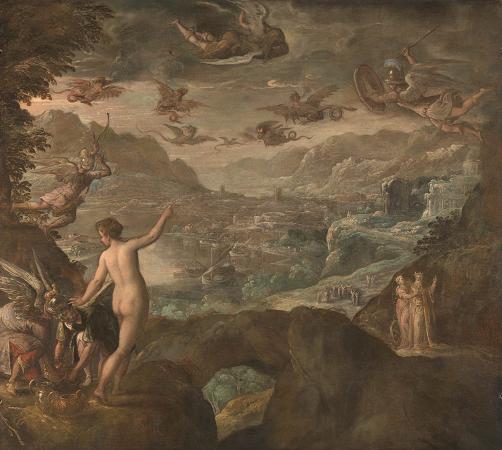Harpies. In Greek mythology and Roman mythology, a harpy is a half-human and half-bird personification of storm winds. They feature in Homeric poems. They were generally depicted as birds with the heads of maidens, faces pale with hunger and long claws on their hands. Roman and Byzantine writers detailed their ugliness. Pottery art depicting the harpies featured beautiful women with wings. Ovid described them as human-vultures. To Hesiod, they were imagined as fair-locked and winged maidens, who surpassed winds and birds in the rapidity of their flight. .the Harpyiai of the lovely hair, Okypete and Aello, and these two in the speed of their wings keep pace with the blowing winds, or birds in flight, as they soar and swoop, high aloft. But even as early as the time of Aeschylus, they are described as ugly creatures with wings, and later writers carry their notions of the harpies so far as to represent them as most disgusting monsters. The Pythian priestess of Apollo recounted the appearance of the harpies in the following lines: Before this man an extraordinary band of women slept, seated on thrones. No! Not women, but rather Gorgons I call them; and yet I cannot compare them to forms of Gorgons either. Once before I saw some creatures in a painting, carrying off the feast of Phineus; but these are wingless in appearance, black, altogether disgusting; they snore with repulsive breaths, they drip from their eyes hateful drops; their attire is not fit to bring either before the statues of the gods or into the homes of men. I have never seen the tribe that produced this company, nor the land that boasts of rearing this brood with impunity and does not grieve for its labor afterwards. Bird-bodied, girl-faced things they are; abominable their droppings, their hands are talons, their faces haggard with hunger insatiable They are said to have been feathered, with cocks' heads, wings, and human arms, with great claws; breasts, bellies, and female parts human. The harpies seem originally to have been wind spirits. Their name means snatchers or swift robbers and they steal food from their victims while they are eating and carry evildoers to the Erinyes. When a person suddenly disappeared from the Earth, it was said that he had been carried off by the harpies. Thus, they carried off the daughters of king Pandareus and gave them as servants to the Erinyes. In this form they were agents of punishment who abducted people and tortured them on their way to Tartarus. They were vicious, cruel and violent. The harpies were called the hounds of mighty Zeus thusministers of the Thunderer. Later writers listed the harpies among the guardians of the underworld among other monstrosities including the Centaurs, Scylla, Briareus, Lernaean Hydra, Chimera, Gorgons and Geryon. Their abode is either the islands called Strofades, a place at the entrance of Orcus, or a cave in Crete. Hesiod calls them two lovely-haired creatures, the daughters of Thaumas and the Oceanid Electra and sisters of Iris. Hyginus, however, cited a certain Ozomene as the mother of the harpies but he also recounted that Electra was also the mother of these beings in the same source. This can be explained by the fact that Ozomene was another name for Electra. The harpies possibly were siblings of the river-god Hydaspes and Arke, as they were called sisters of Iris and children of Thaumas. According to Valerius, Typhoeus was said to be the father of these monsters while a different version by Servius told that the harpies were daughters of Pontus and Gaea or of Poseidon. They are named Aello and Ocypete, and Virgil added Celaeno as a third. Homer knew of a harpy named Podarge. Aello, is sometimes also spelled Aellopus or Nicothoe; Ocypete, sometimes also spelled Ocythoe or Ocypode. Homer called the harpy Podarge as the mother of the two horses of Achilles sired by the West Wind Zephyrus while according to Nonnus, Xanthus and Podarkes, horses of the Athenian king Erechtheus, were born to Aello and the North Wind Boreas. Other progeny of Podarge were Phlogeus and Harpagos, horses given by Hermes to the Dioscuri, who competed for the chariot-race in celebration of the funeral games of Pelias. The swift horse Arion was also said to begotten by loud-piping Zephyrus on a harpy, as attested by Quintus Smyrnaeus.
more...



